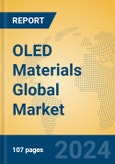Introduction
OLED Materials encompass organic compounds used in organic light-emitting diode (OLED) displays, including hole transport, electron transport, hole injection, electron injection, and emitting materials. The OLED materials industry is characterized by its critical role in high-resolution, energy-efficient displays for smartphones, TVs, lighting, and other applications. Key trends include the development of phosphorescent and thermally activated delayed fluorescence (TADF) materials, sustainable formulations, and innovations for micro-OLEDs in AR/VR. The market is driven by demand for premium displays in consumer electronics and automotive, particularly in Asia Pacific. The industry faces challenges from high R&D costs and competition from alternative display technologies.Market Size and Growth Forecast
The global OLED Materials market was valued at USD 14.7-26.9 billion in 2024, with an estimated CAGR of 10.0%-12.0% from 2025 to 2030, driven by smartphone and OLED TV applications.Regional Analysis
- North America is projected to grow at a CAGR of 9.8%-11.8%, with the U.S. leading due to its consumer electronics and AR/VR sectors, focusing on micro-OLED materials.
- Europe is expected to achieve a CAGR of 9.5%-11.5%, with Germany driving demand through its automotive display industries.
- Asia Pacific is anticipated to record the highest growth at 10.5%-12.5%, led by China, South Korea, and Japan, where OLED display production fuels demand, with trends toward localized supply chains.
- Rest of the World, particularly Brazil, is expected to grow at 9.3%-11.3%, supported by emerging consumer electronics markets.
Application Analysis
- OLED TV applications are estimated to grow at a CAGR of 10.3%-12.3%, driven by demand for large, high-resolution displays, with trends toward phosphorescent materials for efficiency.
- OLED lighting applications are projected to expand at 9.8%-11.8%, supported by energy-efficient lighting, with innovations in flexible OLEDs.
- Smartphone applications are expected to grow at 10.5%-12.5%, focusing on foldable and micro-OLED displays, with advancements in TADF materials.
- Other applications, including wearables, are anticipated to grow at 9.5%-11.5%, with developments in durable formulations.
Type Analysis
- Hole transport materials are estimated to grow at a CAGR of 10.0%-12.0%, driven by their role in charge mobility, with trends toward high-stability compounds.
- Electron transport materials are projected to expand at 10.0%-12.0%, supported by demand for efficient electron flow, with innovations in low-voltage materials.
- Hole injection materials are expected to grow at 9.8%-11.8%, focusing on reducing energy barriers, with advancements in high-purity grades.
- Electron injection materials are anticipated to grow at 9.8%-11.8%, driven by improved electron injection efficiency, with trends toward durable formulations.
- Emitting materials are estimated to grow at 10.5%-12.5%, supported by demand for vibrant colors, with innovations in TADF and phosphorescent emitters.
Key Market Players
DuPont, headquartered in Wilmington, USA, produces OLED materials for displays, known for its advanced organic compounds.Merck KGaA, based in Darmstadt, Germany, supplies OLED materials for smartphones, focusing on high-efficiency emitters.
Idemitsu Kosan, headquartered in Tokyo, Japan, provides OLED materials for TVs, emphasizing phosphorescent technologies.
Solus Advanced Materials, based in Iksan, South Korea, offers OLED materials for displays, known for scalable production.
LG Chem, headquartered in Seoul, South Korea, supplies OLED materials for lighting, focusing on flexible formulations.
Toray, based in Tokyo, Japan, produces OLED materials for smartphones, emphasizing high-purity compounds.
DUKSAN Neolux, headquartered in Cheonan, South Korea, provides OLED materials for TVs, known for TADF innovations.
Universal Display Corporation, based in Ewing, USA, supplies OLED materials for displays, focusing on phosphorescent emitters.
Porter’s Five Forces Analysis
- The threat of new entrants is low; high R&D costs and patent barriers create significant challenges.
- The threat of substitutes is moderate; LCD and micro-LED compete, but OLED’s color quality maintains its edge.
- Buyer power is moderate; display manufacturers negotiate pricing, but specialized materials limit their leverage.
- Supplier power is moderate; raw material scarcity creates some dependency.
- Competitive rivalry is high; players differentiate through TADF and phosphorescent innovations.
Market Opportunities and Challenges
Opportunities
- Growth in foldable smartphones and micro-OLEDs for AR/VR drives OLED material demand.
- Expansion of OLED TVs in premium markets enhances market opportunities.
- Emerging markets in Asia Pacific offer growth potential for OLED displays.
Challenges
- High R&D costs for advanced materials limit scalability.
- Competition from micro-LED and LCD challenges market share.
- Supply chain constraints for raw materials impact production.
Growth Trend Analysis
The OLED Materials market is experiencing rapid growth, driven by demand for high-resolution displays. On September 27, 2024, LG Display sold its Guangzhou LCD plant stake to TCL’s CSOT for USD 1.54 billion, signaling a shift toward OLED production. On November 21, 2024, Applied Materials introduced the MAX OLED™ solution, enhancing OLED display manufacturing for tablets and PCs. On May 13, 2025, Samsung showcased micro-OLED panels at SID Display Week 2025, targeting brighter, high-resolution headsets. These developments align with a projected CAGR of 10.0%-12.0% through 2030, reflecting OLED materials’ role in premium displays.This product will be delivered within 1-3 business days.
Table of Contents
Companies Mentioned
- DuPont
- Merck KGaA
- Idemitsu Kosan
- Solus Advanced Materials
- LG Chem
- Toray
- DUKSAN Neolux
- Universal Display Corporation
- Hodogaya Chemical
- SAMSUNG SDI
- HANCHEM
- JSR
- Beijing Sineva Technology
- Guangzhou ChinaRay
- Eternal Material Technology
- JiLin OLED Material Tech
- Shaanxi Lighte Optoelectronics Material
- PhiChem
- Kyung-In Synthetic Corporation (KISCO)
- Shijiazhuang Slichem Display Material








